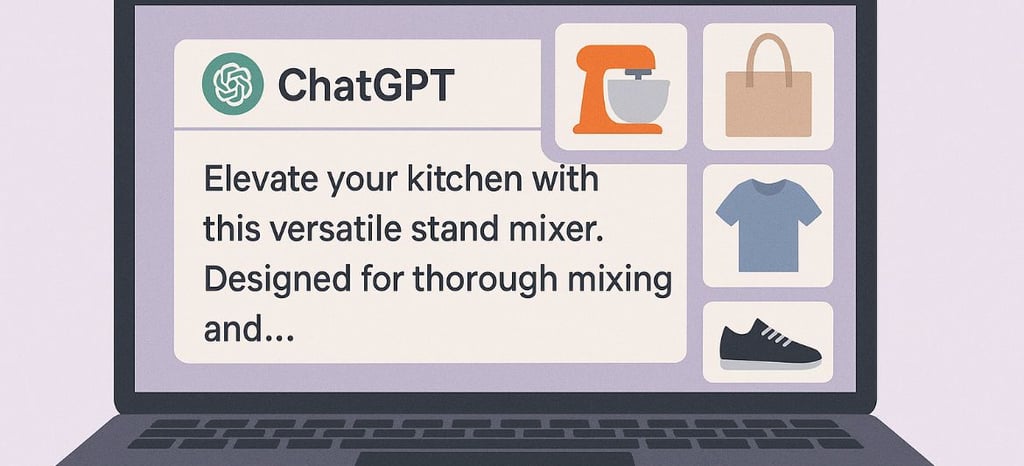
Master Tech skills on the go...
How to Use ChatGPT to Generate Product Descriptions at Scale
Unlock how to use ChatGPT to generate product descriptions at scale: master prompt engineering, API workflows, quality control, and SEO optimization for e-commerce success.
AI TOOLS & PROMPT ENGINEERING
By OnlineTechSkills Editorial Team
5/15/20255 min read


Imagine you’re launching or managing an online store with dozens, hundreds, or even thousands of SKUs. Writing unique, engaging, and SEO-friendly product descriptions for each one can eat up endless hours. That’s where ChatGPT steps in: it can spin up tailored descriptions in seconds, helping agencies, freelancers, and e-commerce teams work smarter, not harder.
Below, we’ll walk through a step-by-step framework for setting up, running, and optimizing ChatGPT-driven product description workflows, complete with practical tips, real-world examples, and recommended resources.
Why Product Descriptions Matter and Why They Stall
Behind every sale are two key copy elements: the title that grabs attention, and the description that convinces a customer to click Add to Cart. Great product copy:
Highlights benefits and use cases
Addresses pain points and objections
Speaks your brand’s voice
Incorporates SEO keywords to drive organic traffic
But writing these by hand is painful at scale. You’ll face:
Writer’s block when every product feels similar
Inconsistency across categories and writers
Missed deadlines when descriptions slip down your to-do list
Duplicate content penalties if you copy manufacturer text
AI tools like ChatGPT solve these pain points by generating unique, on-brand descriptions in bulk without the burnout.
Core Ingredients of an Effective Product Description
Before jumping into prompts, let’s break down what goes into a persuasive description:
Headline or Hook: A one-line teaser: “Ultra-soft bamboo toothbrush for sensitive gums.”
Feature List: Key specs: material, dimensions, compatibility.
Benefit Focus: Explain how features translate to user value: “Bamboo handle reduces plastic waste, caring for your teeth and the planet.”
Tone and Voice: Casual, professional, playful must match your brand persona.
SEO Keywords: Naturally woven in, e.g., “eco-friendly toothbrush,” “vegan dental care.”
Call to Action: Subtle nudges: “Add to cart now for a cleaner, greener smile.”
When you know these elements, you can craft prompts that explicitly request each piece ensuring consistent output.
Laying the Groundwork
Successful scaling begins well before you ever hit “Generate.” Invest time in:
Catalog Audit:
Identify product attributes you have (e.g., name, category, features, specs, use cases).
Highlight gaps in data you’ll need (e.g., dimensions, materials, brand story).
Brand Guidelines:
Define tone (e.g., playful, authoritative, friendly).
Outline do’s and don’ts (e.g., avoid jargon, always mention USPs first).
SEO Keyword List:
Gather high-priority keywords for each category.
Group keywords by intent (e.g., “buy running shoes,” “best water bottle for hiking”).
Pro Tip: For comprehensive SEO research workflows, check out our guide on how to use AI for keyword research and SEO optimization.
Prompt Engineering Basics for Product Copy
Prompt engineering is the craft of writing instructions that guide AI to deliver exactly what you need. For product descriptions, follow this formula:
Generate a product description for [Product Name]. Include:
1. A catchy one-line headline.
2. A 2–3 sentence overview focusing on benefits.
3. A bullet-point list of three key features.
4. Two long-tail SEO keywords: [keyword1], [keyword2].
5. A closing call to action. Tone: [brand voice description]. Word count: 80–100 words.
Example Prompt:
Generate a product description for “SolarSpin R900 Solar Charger.” Include:
1. A catchy one-line headline.
2. A 2–3 sentence overview focusing on benefits.
3. A bullet-point list of three key features.
4. Two long-tail SEO keywords: “portable solar power bank,” “sustainable camping gear.”
5. A closing call to action. Tone: enthusiastic, eco-friendly. Word count: 90–100 words.
This prompt ensures every description ticks all your boxes. At scale, slight prompt tweaks yield drastic quality shifts. Follow these principles:
Be Specific:
Instead of “Write a product description,” use:
“Write a 60-word description for a stainless-steel insulated water bottle. Emphasize leak-proof design, BPA-free materials, and 24-hour temperature retention. Tone: friendly, outdoor enthusiast.”
Provide Structure:
List sections you want:
Title:
Hook:
Key Features (bullet points):
Call to Action:
Include Examples:
In your prompt, show a model description for a different product. ChatGPT will mimic style.
Iterate with System Messages:
When using the API, set a system message like:
“You are a senior copywriter specializing in outdoor gear. Write concise, benefit-driven product descriptions.”
For a deep dive into crafting effective prompts, see our beginner’s guide to prompt engineering with AI tools.
Choosing Between Prompting and Fine-Tuning
Prompting:
Pros: No extra cost beyond API calls; highly flexible.
Cons: Occasional inconsistencies; prompt length limits.
Fine-Tuning:
Pros: Model “remembers” your brand voice; more consistent formatting.
Cons: Training data prep; higher per-call cost; retraining when guidelines change.
Actionable Step:
Begin with prompt-based generation. If you find yourself repeating lengthy instructions, export 100–200 high-quality pairs (product data + ideal descriptions) to fine-tune a model. This often pays off when generating thousands of descriptions.
Leveraging Prompt Templates and Automation Tools
Manually coding scripts is powerful but can be laborious. Consider:
No-Code Platforms: Zapier, Make (formerly Integromat), or Workato can orchestrate:
Trigger: New row in Google Sheets.
Action: Send prompt to ChatGPT.
Action: Write result to your CMS.
Prompt Template Libraries:
Store your best-performing prompts in tools like PromptPerfect or bespoke internal tooling.
Version Control for Prompts:
Use Git to track prompt changes and A/B test variations over time.
If you’re evaluating automation platforms, see our comparison: IFTTT vs Zapier vs Make—Which to Use When.
Ensuring Quality and Consistency
Automation speeds things up, but oversight is key:
Batch Review:
Sample 5–10% of generated copy weekly.
Check for factual errors, tone drift, and SEO compliance.
Human-in-the-Loop:
Surface low-confidence generations (e.g., model indicates uncertainty) to editors.
Style Guides & Glossaries:
Maintain brand-specific term lists (e.g., “’ultra-grip’ not ‘super-grip’”).
Programmatically flag forbidden words via simple text-scan scripts.
A/B Testing:
Split test different prompt variants (e.g., “mention eco-friendly” vs. “mention leak-proof”).
Continuous Optimization with Metrics
Track KPIs to refine your approach:
Conversion Rate (CR): % of page visitors who click “Add to Cart.”
Average Time on Page: Indicator of engagement.
SEO Rankings: Keyword position changes after copy refresh.
Return and Cancellation Rates: May point to misleading descriptions.
Actionable Step:
Set up dashboards (e.g., Looker, Data Studio) to correlate description versions with performance metrics. Regularly retrain or adjust prompts based on data insights.
Advanced Techniques
Dynamic Personalization:
Use user-data (location, past purchases) in your prompts:
“Write a description highlighting features first‐time runners care about…”
Multilingual Generation:
Chain prompts:
Generate in English.
Ask ChatGPT to translate, maintaining tone.
Or leverage multilingual models directly.
Retrieval-Augmented Generation (RAG):
Index detailed product specs in a vector store.
Include top-k relevant facts in prompts to boost accuracy.
Fine-Grained Structuring:
Automate bulleted feature lists, specs tables, and callouts via prompt instructions.
Complementary Resources
Brainstorming Product Angles:
For ideation beyond descriptions, see how to use ChatGPT for research, writing, and brainstorming.Content Creation Toolbox:
Discover the best free AI tools for content creation to supplement ChatGPT (image generation, SEO analysis, readability checks).
Putting It All Together: A Sample Workflow
Data Prep: Export product CSV with all metadata.
Prompt Drafting: Write and test prompt templates in the OpenAI Playground.
Scripted Generation: Run Python or no-code flows overnight.
Quality Control: Automated checks + weekly editor reviews.
Deployment: Sync finalized descriptions to your storefront.
Analytics and Iteration: Monitor performance; tweak prompts or retrain model as needed.
Conclusion
Generating product descriptions at scale doesn’t have to be a slog. By combining clear prompt engineering with automation, you can transform weeks of work into hours. You’ll maintain quality, keep your brand voice consistent, and free up your team for higher-impact tasks, marketing strategy, new product ideation, or deeper customer engagement.
Start small: test a handful of products, refine your workflow, then expand. With the right template, a bit of code or no-code magic, and ChatGPT’s writing prowess, you’ll outpace competitors and delight customers with compelling descriptions every time.
Ready to accelerate your e-commerce content engine? Pick a prompt template, hook up your data source, and let ChatGPT handle the heavy lifting.
Insights
Explore our free and top ranking blogs for in-demand tech skills.
CONTACT US
Support
support@onlinetechskills.com
© 2025. All rights reserved.